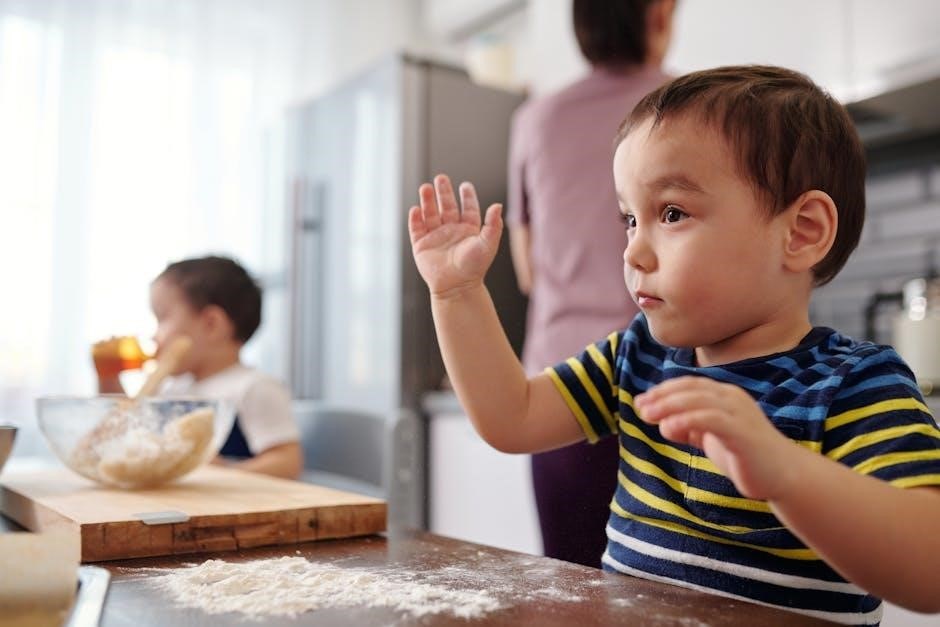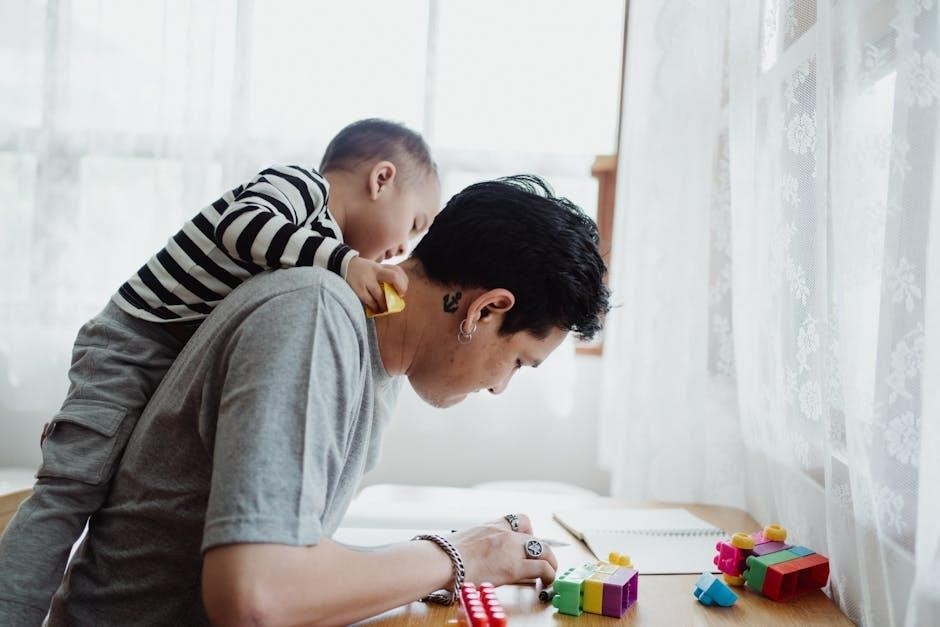Addiction profoundly impacts family dynamics, creating distinct roles such as the addict, enabler, and hero, which influence coping mechanisms and recovery processes.
Family roles often emerge as a response to the addict’s behavior, shaping interactions and creating a complex web of codependency and enabling patterns.
1.1 Understanding the Concept of Family Roles
Family roles in addiction refer to the distinct patterns of behavior and responsibilities that emerge within families affected by substance abuse. These roles, such as the addict, enabler, or hero, develop as coping mechanisms to manage the chaos caused by addiction. They are often subconscious and shaped by the need to maintain balance or protect the family image. Understanding these roles is crucial, as they influence dynamics, communication, and recovery processes. Recognizing these patterns helps families address unhealthy behaviors and work toward healthier interactions. These roles are not fixed and can evolve as the family seeks support and healing.
1.2 The Impact of Addiction on Family Dynamics
Addiction disrupts family dynamics, creating chaos and altering relationships. It distorts traditional roles, leading to maladaptive behaviors like enabling or people-pleasing. Family members often develop emotional and mental health issues, such as anxiety or depression, as they cope with the addict’s unpredictable moods and actions. Communication patterns become strained, with secrecy and denial prevailing. Boundaries are blurred, and trust erodes, making it difficult to maintain a stable environment. Over time, these changes can lead to a dysfunctional hierarchy where the addict’s needs dominate, further entrenching unhealthy patterns and hindering recovery efforts for both the individual and the family as a whole.
1.3 The Importance of Addressing Family Roles in Recovery
Addressing family roles is crucial for effective recovery, as these roles often perpetuate codependency and enabling behaviors. By understanding and transforming these dynamics, families can break cycles of dysfunction. Recovery requires the addict to take accountability while others shift from enabling to supportive roles. This process fosters healthier communication and boundaries. Family members must also heal from emotional wounds, reducing resentment and frustration. A compassionate and structured approach to addressing these roles creates an environment conducive to recovery, ensuring all members grow and thrive together, rather than remaining entangled in harmful patterns.

Common Family Roles in Addictive Families
Addiction disrupts family dynamics, leading to distinct roles like the addict, enabler, hero, scapegoat, lost child, and mascot. These roles shape interactions and coping mechanisms.
2.1 The Addict
The addict is often the central figure in the family, with their behavior dictating the household’s dynamics. Their substance use creates chaos, leading family members to adapt by taking on specific roles. The addict’s unpredictable moods and actions force others to navigate a volatile environment, often sacrificing their own needs. This central role can distort traditional family functions, as the addict’s addiction becomes the primary focus, overshadowing other relationships and responsibilities. The addict’s struggle with addiction deeply affects every family member, creating a ripple effect of emotional and mental health challenges.
2.2 The Enabler
The enabler, often a family member, unintentionally supports the addict’s behavior by covering up consequences or providing financial support. This role stems from a desire to protect the addict and maintain stability but ultimately perpetuates the addiction. Enablers may feel responsible for the addict’s well-being, leading to sacrificing their own needs and boundaries. Their actions, though well-meaning, prevent the addict from facing the reality of their actions, hindering recovery. The enabler’s role is complex, often fueled by fear, guilt, or emotional attachment, making it challenging to break the cycle of enabling behaviors.
2.3 The Hero
The hero emerges as the high-achieving family member who compensates for the addict’s failures by excelling in various areas. This role often involves taking on excessive responsibilities to maintain a sense of normalcy and stability. The hero may feel pressured to be perfect, masking their own emotional struggles. While their efforts provide temporary relief, they can also perpetuate dysfunction by distracting from the addict’s issues. Over time, the hero may develop resentment or burnout, highlighting the need for a balanced approach to family dynamics in recovery.
2.4 The Scapegoat
The scapegoat is often the family member blamed for the addict’s behavior, diverting attention from the addiction itself. This role can lead to emotional isolation and low self-esteem. The scapegoat may act out through rebellion or risky behavior, further reinforcing their role. While this dynamic provides temporary relief for others, it prevents addressing the addiction directly. Recognizing and challenging this role is crucial for healing, as it allows the family to confront the addiction and work towards healthier communication patterns. The scapegoat’s struggles often highlight the broader dysfunction within the family system.
2.5 The Lost Child
The lost child often withdraws from family interactions, seeking isolation as a coping mechanism. They may feel invisible or neglected due to the addict’s dominating presence. This role involves suppressing emotions and avoiding conflict, which can lead to feelings of loneliness and disconnection. The lost child may struggle with low self-esteem and difficulty forming healthy relationships outside the family. Their isolation can prevent them from seeking help or expressing their needs, further entrenching their role within the dysfunctional family dynamic. This pattern can persist into adulthood, affecting their ability to form intimate connections and maintain emotional well-being.
2.6 The Mascot
The mascot is the family member who uses humor or positivity to mask the tension and emotional pain caused by addiction. They often distract others from the addict’s behavior, attempting to maintain a sense of normalcy. This role involves suppressing their own emotions and avoiding conflict, which can lead to emotional detachment. The mascot may feel responsible for keeping the family’s morale high, but this coping mechanism can prevent the family from addressing the addiction directly. Over time, the mascot may struggle with feelings of resentment or isolation, as their efforts to lighten the mood can hinder genuine communication and healing.

The Role of Codependency in Family Dynamics
Codependency arises when family members enable addictive behaviors, often to cope with emotional pain, creating a cycle that hinders recovery and distorts healthy communication patterns.
3.1 Defining Codependency
Codependency is a dysfunctional relationship pattern where individuals prioritize others’ needs over their own, often enabling addictive behaviors. It stems from emotional dependency and fear of abandonment, leading to maladaptive coping mechanisms. In families affected by addiction, codependency manifests as excessive caretaking, denial of personal feelings, and difficulty setting boundaries. This dynamic perpetuates the cycle of addiction by reinforcing enabling behaviors, making it challenging for both the addict and the codependent to seek healthier patterns of interaction. Understanding this concept is crucial for breaking the cycle and fostering recovery within the family system.
3;2 How Family Roles Contribute to Codependency
Family roles in addictive households often create codependent relationships. The addict’s behavior distorts traditional roles, leading family members to adopt specific coping mechanisms. For instance, the enabler’s excessive caretaking reinforces the addict’s dependency, while the hero’s overachieving compensates for the addict’s failures. These roles create a cycle of dependency, where family members’ self-worth becomes tied to the addict’s behavior. Codependency arises as individuals prioritize the addict’s needs over their own, fostering enabling patterns and emotional suppression. This dynamic perpetuates addiction by avoiding confrontation and maintaining dysfunctional harmony, making it challenging for both the addict and family members to break free from these destructive patterns.
3.3 Breaking the Cycle of Codependency
Breaking the cycle of codependency requires recognizing and challenging maladaptive family roles. Therapy and support groups help family members identify enabling behaviors and develop healthier communication patterns. Setting boundaries and prioritizing self-care are crucial steps in reclaiming individual identities. Family members must learn to detach with love, allowing the addict to take responsibility for their actions. Professional guidance can facilitate this process, fostering emotional independence and reducing the need for control or rescue. Ultimately, breaking codependency promotes a balanced family dynamic, encouraging personal growth and mutual respect. This transformation is essential for sustainable recovery and long-term healing for all involved.
The Impact of Addiction on Family Members
Addiction causes emotional turmoil, mental health issues like anxiety and depression, strained relationships, and financial stress. Family members often neglect self-care, leading to burnout and resentment.
4.1 Emotional and Mental Health Consequences
Addiction in a family member often leads to emotional turmoil, including anxiety, depression, and feelings of helplessness. Family dynamics become strained, causing mental health issues like guilt, shame, and resentment. The constant unpredictability of the addict’s behavior creates a stressful environment, affecting everyone’s well-being. Emotional strain can lead to burnout, as family members may neglect their own needs while trying to cope. The mental health consequences can be long-lasting, impacting relationships and overall family stability. Recognizing these emotional challenges is crucial for addressing the broader impact of addiction on the family system.
4.2 Physical Health Implications
Addiction’s impact extends beyond mental health, affecting the physical well-being of family members. Chronic stress from dealing with an addict can lead to hypertension, a weakened immune system, and sleep disorders. Family members may neglect their own health, leading to conditions like chronic pain or gastrointestinal issues. Additionally, secondary health risks arise from a strained living environment, such as poor nutrition and lack of exercise. The physical toll underscores the need for holistic support to address both the addict’s and the family’s health challenges in recovery. Early intervention is essential to prevent long-term physical damage.

4.3 Financial Burden on the Family
Addiction imposes significant financial strain on families. Costs include medical bills, legal fees, and lost wages due to the addict’s reduced productivity. Family members often deplete savings or incur debt to cover these expenses. Caregivers may sacrifice their own financial stability to support the addict, leading to long-term economic hardship. The financial burden exacerbates stress and limits resources for education, healthcare, and other essential needs. This cycle can perpetuate poverty and limit opportunities for recovery and societal reintegration for both the addict and their family. Financial challenges are a pervasive consequence of addiction, affecting the entire household’s well-being and future stability.

Family Communication Patterns in Addiction
Addiction disrupts healthy communication, fostering secrecy, denial, and emotional suppression. Family members may adopt maladaptive patterns to avoid conflict, enabling the addict’s behavior and perpetuating dysfunction.
5.1 Maladaptive Communication Styles
Addiction often leads to distorted communication patterns within families. Family members may adopt styles like blaming, emotional suppression, or passive-aggressiveness to avoid confrontation. These patterns prevent open dialogue about the addiction, enabling it to persist. Secrecy and denial become common, shielding the addict from accountability while fostering resentment among others. Such communication styles reinforce unhealthy dynamics, making it difficult for the family to address the addiction honestly and constructively. Over time, these maladaptive behaviors can deepen emotional distance and hinder the recovery process for both the addict and the family.
5.2 The Role of Secrets and Denial
Addiction often thrives in an environment of secrecy and denial. Family members may hide the addict’s behavior to protect the family’s image or avoid stigma. This secrecy prevents honest communication and reinforces the addiction, as the addict avoids accountability. Denial becomes a coping mechanism, allowing family members to ignore the problem’s severity. Such behaviors create a toxic cycle where the addiction worsens, and emotional distance grows among family members. Breaking these patterns is essential for recovery, as secrecy and denial act as barriers to addressing the addiction openly and seeking necessary support.
5.3 Improving Communication in Recovery
Effective communication is a cornerstone of recovery, helping families heal and rebuild trust; Open dialogue allows family members to express emotions and concerns honestly, fostering understanding and empathy. Active listening and nonjudgmental exchanges create a safe environment for sharing. Setting clear boundaries and using “I” statements instead of blame can reduce conflict. Professional guidance, such as therapy, can further enhance communication skills. By addressing past hurts and promoting transparency, families can establish healthier interaction patterns, supporting the addict’s recovery and strengthening overall relationships. Improved communication paves the way for a more supportive and collaborative family dynamic.

The Role of Family in the Recovery Process
Families play a vital role in recovery by providing emotional support, fostering a nurturing environment, and encouraging participation in therapy and support groups.
6.1 Supporting the Addict in Recovery
Supporting the addict in recovery requires a compassionate and non-judgmental approach. Family members must educate themselves about addiction as a disease, fostering empathy and understanding. Creating a supportive environment involves encouraging open communication and active participation in therapy. Setting realistic expectations and celebrating small milestones can boost the addict’s morale. It’s crucial to avoid enabling behaviors while promoting healthy boundaries. Professional guidance and family therapy can provide tailored strategies for effective support. Additionally, engaging in family support groups can offer emotional relief and practical advice, helping the family navigate the recovery journey together and fostering long-term healing for all members.
6.2 The Importance of Family Therapy
Family therapy plays a pivotal role in addressing the systemic impact of addiction. It provides a safe space for members to express emotions, set boundaries, and rebuild trust. By identifying and challenging maladaptive patterns, therapy fosters healthier communication and conflict resolution. Professional guidance helps the family understand addiction as a collective issue, not an individual problem. Therapy also empowers members to support the addict’s recovery while prioritizing their own well-being. This collaborative approach strengthens family dynamics, promoting a supportive environment for sustainable healing and preventing relapse by addressing underlying issues that contribute to addictive behaviors.
6.3 Involving Family in Relapse Prevention
Family involvement is crucial in relapse prevention, as their support and understanding can significantly impact the addict’s recovery journey. Educating family members about addiction as a disease helps reduce stigma and encourages empathy. They can participate by monitoring triggers, fostering a supportive environment, and reinforcing healthy behaviors. Families should learn to identify early warning signs of relapse and develop strategies to address them collectively. Active involvement in therapy sessions and support groups further strengthens the family’s role in maintaining sobriety. By working together, families can create a resilient network that aids in long-term recovery and prevents relapse.
Understanding Family Dynamics in Addiction
Addiction disrupts family dynamics, altering roles, boundaries, and communication patterns, which often leads to dysfunctional interactions and codependency among members, complicating recovery efforts significantly.
7.1 The Hierarchy and Boundaries in Addictive Families
Addiction often disrupts the natural hierarchy and boundaries within families, creating an unstable environment where roles become distorted. The addict may become the central focus, leading to a power imbalance and blurred boundaries. This can result in enmeshment or detachment among family members.
Dysfunctional hierarchies may enable addictive behaviors, as other family members adapt to the addict’s needs, sacrificing their own. Healthy communication and decision-making processes are often compromised, leading to further emotional and relational challenges.
Reestablishing clear boundaries and a balanced hierarchy is essential for recovery, requiring effort and often professional guidance to promote a healthier family dynamic.
7.2 Rituals and Rules in Dysfunctional Families
In dysfunctional families affected by addiction, rituals and rules often become distorted or rigid, creating a chaotic environment. These patterns may reinforce codependency and enabling behaviors, perpetuating the cycle of addiction.

Rules may be inconsistently enforced, leading to confusion and instability. Rituals, such as avoiding discussions about the addiction, can prevent open communication and maintain denial within the family system.
Addressing these unhealthy rituals and rules is crucial for recovery; Families must establish clear, adaptive guidelines and foster honest interactions to break free from dysfunctional cycles and promote healing.
7.3 The Interconnectedness of Family Roles
Family roles in addiction are deeply interconnected, creating a complex system that reinforces dysfunctional behaviors. Each role, such as the addict, enabler, or hero, contributes to the cycle of addiction, often unintentionally enabling it. The enabler’s protective behaviors, for instance, can inadvertently support the addict’s habits, while the hero’s attempts to maintain control may suppress emotions and prevent open communication. This interconnectedness fosters codependency and maintains the status quo, making it challenging for individuals to break free from their assigned roles. Recognizing and addressing these interdependencies is crucial for healing and restoring healthy family dynamics.
The Role of the Family in Initiation and Maintenance of Addiction
Addiction initiation and maintenance are often influenced by family dynamics, with enabling behaviors and emotional support unintentionally sustaining the cycle of addiction.
8.1 Family Factors Contributing to Addiction
Family dynamics significantly influence addiction initiation and maintenance. Enabling behaviors, such as covering up for the addict, can inadvertently perpetuate substance use. Dysfunctional communication patterns, including denial and secrecy, often conceal the problem. Additionally, distorted family roles, like the enabler or the hero, create an environment where addiction thrives; Family members may unintentionally support addictive behaviors by normalizing substance use or avoiding confrontation. These factors, rooted in emotional and psychological needs, can create a cycle that sustains addiction within the family system.
8.2 The Role of Family in Enabling Behaviors
Families often unintentionally enable addiction through well-meaning but harmful actions. By covering up, providing financial support, or making excuses, they shield the addict from consequences. This protection prevents the addict from facing reality, hindering recovery efforts. Enabling behaviors stem from fear, guilt, or a desire to maintain family harmony. Over time, these actions reinforce the addiction cycle, making it harder for the addict to seek help. Family members may also develop codependent patterns, further entangling their roles in sustaining the addiction.
8.3 Breaking the Cycle of Enablement
Breaking the cycle of enablement requires families to stop protecting the addict from consequences. Setting boundaries and refusing to cover up or financially support harmful behaviors is crucial. Family members must seek support for themselves, often through therapy or groups like Al-Anon. Education about addiction as a disease helps them understand the need for change. Encouraging responsibility and professional help for the addict fosters an environment for recovery. This shift from enabling to accountability, though challenging, is vital for healing. It allows the family to move beyond dysfunction, promoting healthier dynamics and empowering the addict to seek help.

The Role of Family in Recovery and Healing
Families play a vital role in recovery by providing emotional support, setting boundaries, and engaging in therapy. Their involvement fosters healing and promotes long-term recovery.
9.1 The Transformation of Family Roles in Recovery
In recovery, family roles often shift from enabling or controlling to supportive and healthy. Members learn to redefine their roles, fostering mutual respect and accountability.
Therapy helps families break free from dysfunctional patterns, allowing each member to heal and grow. This transformation is crucial for sustaining long-term recovery and rebuilding trust.
By addressing codependency and establishing boundaries, families create a stable environment that promotes emotional well-being and encourages the addict’s journey toward sobriety and personal growth.
9.2 The Importance of Family Support Groups
Family support groups provide a safe space for members to share experiences and receive guidance, reducing feelings of isolation and stigma associated with addiction.
These groups offer education on addiction as a disease, fostering empathy and understanding. They empower families to adopt healthy coping strategies and support their loved one’s recovery journey.
By connecting with others facing similar challenges, families gain strength, hope, and practical tools to navigate the complexities of addiction and rebuild their lives collectively.

9.3 Rebuilding Healthy Family Dynamics
Rebuilding healthy family dynamics involves restoring balance and harmony among members. This process requires redefining roles, setting clear boundaries, and fostering open communication patterns.
Family therapy plays a crucial role in addressing maladaptive behaviors and fostering empathy. By encouraging mutual understanding and support, families can break free from enabling patterns and codependency.
Empowering each member to embrace their individuality and responsibilities helps create a healthier environment. This transformation supports long-term recovery for the addict and overall well-being for the family.
Addiction deeply impacts families, reshaping roles and dynamics. Addressing these roles and seeking therapy fosters healing, enabling families to rebuild and support recovery effectively together.
10.1 Summary of Key Points
Addiction is a family disease, deeply impacting dynamics and roles. It creates dysfunctional patterns, enabling behaviors, and codependency. Family members adopt roles like the addict, enabler, and hero to cope. These roles distort healthy communication and boundaries, leading to emotional and mental strain. Understanding these dynamics is crucial for recovery. Therapy and support systems help families break cycles of enablement and rebuild healthy interactions. Recovery involves transforming roles and fostering compassion. Families must address their own healing to support the addict effectively. Ultimately, addiction recovery requires a collective effort to restore balance and harmony within the family structure.

10.2 The Path Forward for Families Affected by Addiction
Families affected by addiction can move forward by seeking education, therapy, and support. Professional guidance helps them understand their roles and develop healthier dynamics. Encouraging open communication and honesty fosters trust and healing. Support groups provide a sense of community and shared experiences, aiding in the recovery process. Setting boundaries and prioritizing self-care are essential for emotional well-being. Families must remain patient and committed, as recovery is a long-term journey. By addressing their own needs and working together, families can rebuild their relationships and create a supportive environment for lasting change and growth.
10.3 The Importance of Compassionate Support
Compassionate support is vital for families navigating addiction. Empathy and understanding help bridge gaps, fostering healing and trust. Support groups and therapy provide safe spaces for expression and growth. Without compassion, recovery efforts may falter, intensifying emotional strain. Families must prioritize self-care to avoid burnout, ensuring they can sustain their supportive roles. Compassionate support not only aids the addict but also strengthens the entire family system, promoting resilience and unity. It is the cornerstone of rebuilding healthy relationships and achieving long-term recovery and well-being for all involved.
